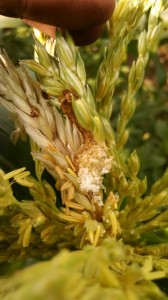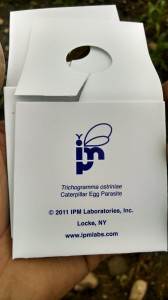Towards the end of July there was a lull, everything was planted, the pests were largely under control, and harvest hadn’t started yet. Half the time the fields were too wet to get on with the equipment without getting stuck and destroying the soil structure. Most of the projects were general maintenance and upkeep of the hopyard and scouting the crops for pests, disease, and deficiencies.
It was during this time that I learned how to scout for the European Corn Borer, a caterpillar pest specifically in sweet corn. The Corn Borer does exactly what the name suggests: eat its way through the corn, significantly reducing the value of the crop. Evidence of their presence, depending on the generation, which depends on the time of year, can be found on more protected parts of the leaves and stalk, or in the tassels and ears. This evidence if fairly obvious, a sort of white, powdery substance around the damaged area. The extent of the infestation is determined by the number of caterpillars found while walking through the field in a random pattern.
This year was a very good year in that there were very few living Corn Borers. I was told that just a couple of years ago the infestation was so bad you couldn’t walk ten feet without finding as many caterpillars. That was a serious infestation. The difference was a newly implemented integrated pest management (IPM) method.
This IPM method was the release of a tiny wasp which parasitized the Corn Borer. The Trichogramma ostriniae come in small packets, about 3″ square, each of which holds about 50,000 wasps. In a ten acre field of sweet corn I would put out somewhere between a dozen or two packets. The wasps were “applied” every few weeks.



Speak Your Mind